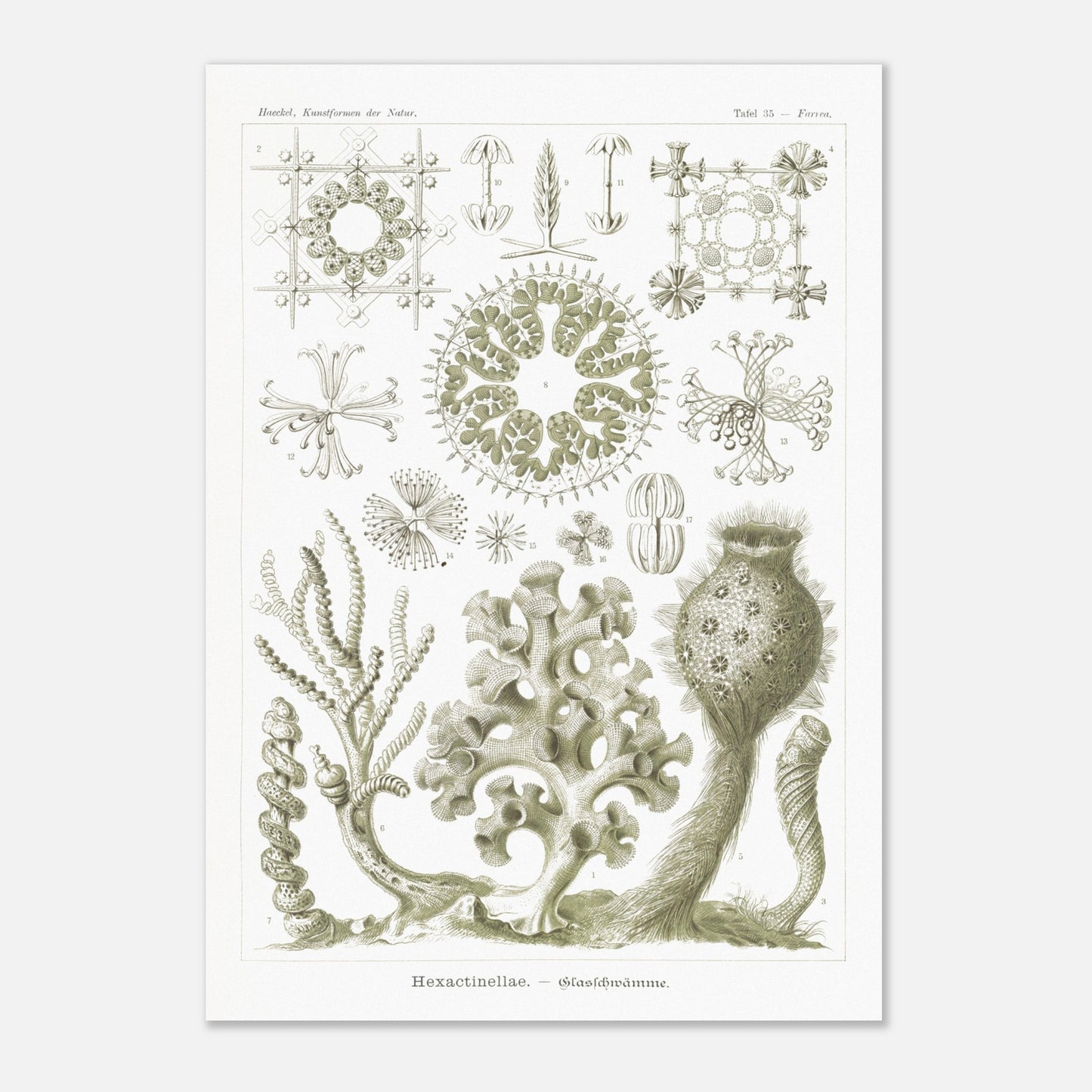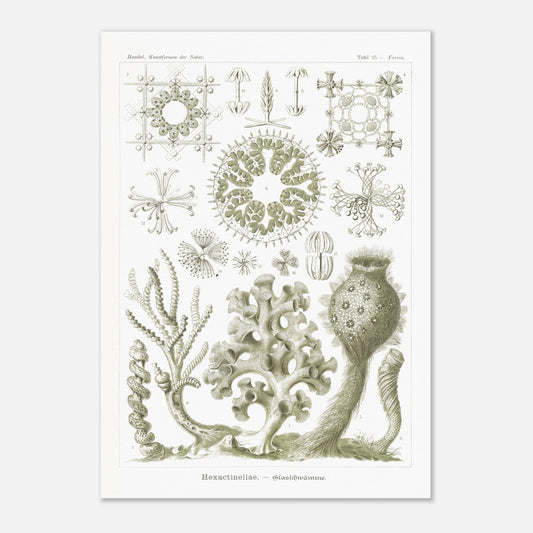Glass sponges - Zoological and botanical plate - Ernst Haeckel, Kunstformen der Natur
Glass sponges - Zoological and botanical plate - Ernst Haeckel, Kunstformen der Natur
Couldn't load pickup availability
Reproduction engraving of: Glass sponges
Original title Hexactinellae - Glasschwämme
Farrea Poster - Sponges of the phylum of sponges or porifera (Class of siliceous sponges, silicispongiae; Order of glass sponges, hexactinellida)
Illustration from the book Kunstformen der Natur, which is a collection of artistic lithographs of natural sciences published by the German biologist Ernst Haeckel between 1899 and 1904.
This naturalistic illustration is part of an overall style inspired by Ernst Haeckel, which greatly influenced the emerging Art Nouveau movement at the beginning of the 20th century. This work, illustrating the impressive beauty and great diversity of the biological world, was complemented by a certain amount of scientific information, some excerpts of which are reproduced below.
This information is over 120 years old and some of it may be outdated!
Scientific classification:
Phylum of Sponges (Spongiae) Class of Siliceous Sponges (Silicispongiae) Order of Glass Sponges (Hexactinellae or Hyalospongiae)
Scientific notice (extract) accompanying the poster print of Hexactinellae - Glass sponges :
Glass sponges or hexactinellid siliceous sponges (Hexactinellae) are distinguished from other sponges by the formation of a delicate siliceous skeleton, the original components of which are six-rayed spicules or needles. The basic geometric form of these delicate siliceous structures is the axial star of the regular cube and octahedron: three equal axes that intersect at right angles in space (like the three axes of the regular crystal system). Sometimes these three axes remain equal, sometimes one or more are elongated or shortened, branched or divided. Sometimes each individual ray is replaced by a brush-like bundle of needles (Fig. 12-17). Each ray may also bear a small disk or star at its free end (Fig. 13, 14). Thousands of these delicate siliceous structures are usually connected within the soft, living body of the sponge to form a framework of varied shape, resembling a work of art made of spun glass. The connection of the spicules within the soft tissue remains loose in the suborder Lyssacines; these are usually anchored in the seafloor mud by a tuft (such as Euplectella and Holtenia, Figs. 3 and 5). In contrast, the connection of the needles becomes very strong by fusion into a rigid framework in the suborder Dictyoninae, which are usually attached to a rocky seafloor (such as Farrea, Figs. 1 and 2, and Sclerothamnus, Figs. 6 and 7). Not only is the extremely varied form of these siliceous frameworks generally very elegant and regular in Hexactinellids, but also the arrangement and form of the water-bearing canals that run through the body of the sponge, and of the flagellum chambers, which are often grouped radially around a canal (Figs. 2, 4, 8). Generally, the imposing colony (or corm) of glass sponges is composed of many small colonies (or cormidia), and these in turn of many flagellum chambers, the true individuals or persons of the sponge.
Species present on the naturalist board of Glass sponges - Farrea :
- Farrea haeckelii
- Euplectella aspergillum
- Holtenia crateromorpha
- Sclerothamnus spiralis
- Polyopogon amadu
- Pheronema rhaphanus
- Hyolonema indicum
- Hyalonema conus
- Regagrella phoenix
- Saccocalyx pedunculata
- Crateromorpha meyeri
- Hyaloslylus dives
- Polylophus philippinensis
- Stylocalyx tenera
About this print
About this print
The layout and composition of this reproduction have been the subject of our greatest attention.
- Respect for the format of the original work: in order to faithfully transcribe the artist's intention, the work is not cropped/re-cut except in extreme cases (obvious imperfection, geometry problem, etc.) in which case the cropping will be as light as possible.
- The presence of white margins is sometimes necessary in order to present the work in a balanced manner.
- Each size offered has been specifically composed, therefore, the size of the white margins may vary from one print size to another. Remember to check this detail carefully!
- Print only, frame not included!
Features
Features
- Premium 200gsm matte white paper, durable and strong.
- Natural, smooth uncoated finish, silky to the touch
- FSC certified paper or equivalent certifications depending on regional availability.
- Each print is shipped in sturdy packaging, ensuring safe transport.
- Each print is printed and shipped on demand. No minimum order quantity is required.
Share !









We are listening to you
If you are looking for a specific composition, a particular layout, or any other customization need, our team is at your disposal and will do everything possible to meet your requests.
So don't hesitate to...




